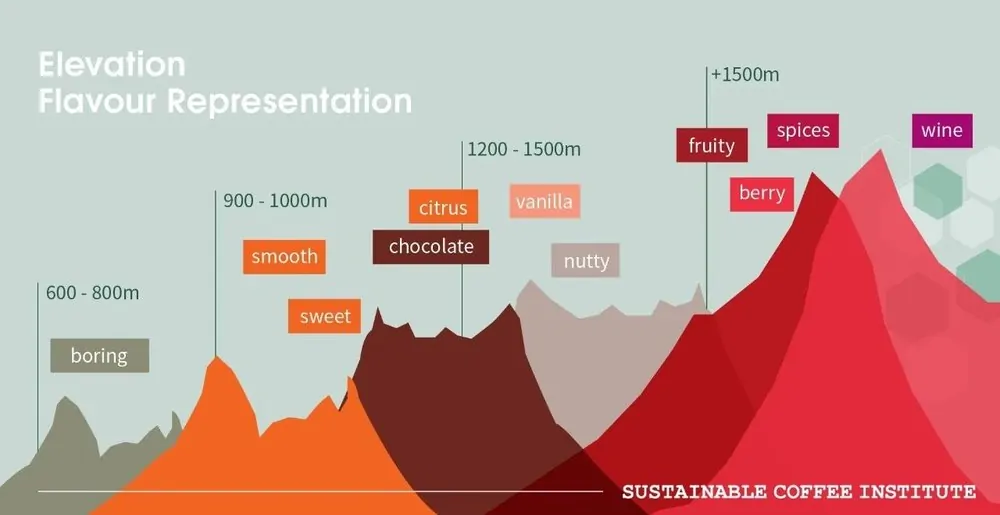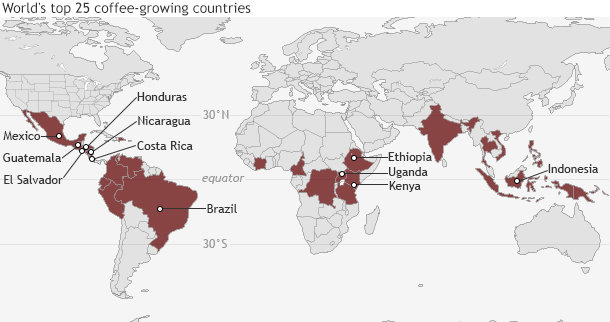Are you a coffee lover curious about what makes your favorite brew taste so unique?
One factor that plays a crucial role in shaping the flavor profile of coffee beans is the altitude at which they are grown.
In this article, we will explore the intricate relationship between altitude and coffee flavors, examining how elevation affects characteristics like acidity, sweetness, and overall taste.
From the science behind altitude’s influence on coffee quality to roasting techniques and key buying tips, we will cover everything you need to know about altitude and its impact on your morning cup of joe.
So grab your favorite mug and join us on a journey through the fascinating world of altitude and coffee.
Key Takeaways:
- Higher altitude coffee beans tend to have a more complex and desirable flavor profile due to slower growth and development, resulting in a more concentrated and nuanced taste.
- Altitude plays a crucial role in the overall taste of coffee, affecting its acidity, sweetness, and overall flavor variations.
- When buying coffee, consider the altitude at which the beans were grown to better understand the potential flavor profile and determine your preference.
The Impact of Altitude on Coffee Flavor Profiles
The Impact of Altitude on Coffee Flavor Profiles is a fascinating subject that delves into how the elevation at which coffee is grown influences its taste and aroma.
Higher altitudes generally result in coffee beans that are more dense and flavorful, often exhibiting brighter acidity and complex floral or fruity notes. Conversely, coffee grown at lower elevations tends to have a milder flavor profile with nuttier or chocolaty undertones. This variance in flavor can be attributed to the slower maturation process of beans at higher altitudes, allowing more time for sugars to develop and resulting in a more nuanced taste.
Understanding the Relationship Between Altitude and Coffee Flavors
Understanding the Relationship Between Altitude and Coffee Flavors is essential for appreciating the complexity and diversity of coffee taste profiles influenced by varying elevations.
At higher altitudes, where the air is thinner and cooler, coffee beans tend to mature more slowly, allowing them to develop intricate flavors. The reduced oxygen levels at higher elevations affect the way beans absorb nutrients from the soil, which in turn impacts the taste of the coffee they produce. This slower growth process results in denser beans with a higher concentration of sugars, ultimately leading to a richer, more complex flavor profile.
Effects of Altitude on Coffee Characteristics
Altitude plays a crucial role in shaping the Effects of Altitude on Coffee Characteristics, influencing factors such as acidity, sweetness, and overall flavor complexity.
As coffee is cultivated at different elevations, the prevailing environmental conditions create a unique terroir that imbues the beans with distinctive qualities. At higher altitudes, where the air is thinner and temperatures cooler, the beans tend to mature more slowly. This gradual ripening process allows the coffee cherries to develop more concentrated sugars, resulting in a higher perceived sweetness in the cup. The acidity levels in coffee grown at higher altitudes are often brighter and more pronounced, adding a delightful zing to the flavor profile. These nuanced flavors, arising from the interplay of elevation, climate, and soil composition, contribute to the complexity and depth of high-altitude coffees.
Altitude and Coffee Acidity
Altitude significantly impacts Coffee Acidity, with higher elevations often leading to vibrant acidity that enhances the overall taste profile.
When coffee is grown at higher altitudes, it tends to develop a more pronounced acidity due to the cooler temperatures, slower maturation process, and decreased oxygen levels in the air. This elevation-driven acidity is often described as bright, tangy, and lively, adding a delightful zing to the coffee’s flavor profile.
The combination of altitude, climate, soil composition, and other environmental factors in a specific region, known as terroir, plays a crucial role in shaping the flavor profile of coffee beans. Coffees grown at higher altitudes in regions like the Andes Mountains or Ethiopian Highlands are renowned for their exceptional acidity and complexity.
Altitude’s Influence on Coffee Sweetness
Altitude’s Influence on Coffee Sweetness is a critical aspect to consider, as higher elevations often result in enhanced sugar concentration and a sweeter flavor profile in coffee beans.
When coffee plants grow at higher altitudes, they experience cooler temperatures and receive more concentrated sunlight, which leads to a slower maturation process.
This longer maturation period allows the coffee cherries to develop higher levels of complex sugars, ultimately influencing the flavor composition of the beans.
The combination of sugar concentration and the slower development process contributes to the nuanced sweetness that can be found in high-altitude coffees.
Overall Taste Variations Based on Altitude
The Overall Taste Variations Based on Altitude showcase the diversity and complexity of flavor profiles influenced by environmental conditions, terroir, and cultivation practices at different elevations.
Coffee aficionados often appreciate how the altitude of a coffee farm can markedly affect the taste of the brewed cup. Beans grown at high altitudes, typically above 3,000 feet, are celebrated for their vibrant acidity, floral notes, and pronounced sweetness. On the other hand, coffee cultivated at lower elevations, around 1,500 feet, tends to boast a more full-bodied flavor with nutty undertones and a balanced acidity. These nuanced taste profiles stem from the variation in temperature, sunlight exposure, and soil composition at different altitudes, culminating in distinctive flavor characteristics that captivate discerning palates.
The Science Behind Altitude and Coffee Quality
The Science Behind Altitude and Coffee Quality delves into the intricate relationship between elevation, environmental conditions, and the quality distinctions between Arabica and Robusta beans.
Altitude plays a crucial role in shaping the flavor profile of coffee beans. At higher elevations, such as those found in mountainous regions, the cooler temperatures slow down the maturation of the beans, resulting in a more complex and developed flavor. The reduced oxygen levels at higher altitudes impact the way beans absorb nutrients, leading to a denser, more flavorful coffee. These environmental factors uniquely influence the growth and composition of Arabica and Robusta coffee beans, creating distinct taste profiles revered by coffee enthusiasts worldwide.
Comparing Arabica and Robusta Suitability to Different Altitudes
Comparing Arabica and Robusta Suitability to Different Altitudes involves assessing how each coffee bean variety thrives at specific elevations, impacting their distinct flavor profiles.
Arabica beans are renowned for their preference for higher altitudes, typically flourishing best between 2000 to 3000 feet above sea level. The cooler climates and rich soils found at these elevations allow Arabica plants to develop slowly, resulting in a more complex and nuanced flavor profile.
On the other hand, Robusta beans exhibit greater resilience to lower altitudes, thriving at sea level to 2000 feet. Robusta’s bold and robust flavor is attributed to its ability to grow rapidly in warmer environments with less need for careful cultivation.
Exploring Altitudes of Coffee-Growing Regions
Exploring Altitudes of Coffee-Growing Regions unveils the diverse terroir and elevation preferences that contribute to the unique flavor profiles of coffee from different regions.
Coffee growers worldwide carefully select the altitude at which they cultivate their beans, as this decision significantly impacts the final taste of the coffee. The higher altitudes provide cooler temperatures and stable humidity levels, which are ideal for slow bean maturation, resulting in more flavorful and complex beans.
Altitude directly influences the chemical composition of the coffee cherry, enhancing the development of sugars and acids that give distinctive characteristics to the final brew. From the high-altitude regions of Latin America to the lower elevations of Southeast Asia, each cup of coffee tells a story of its origins.
Roasting Techniques and Altitude Considerations
Roasting Techniques and Altitude Considerations play a vital role in preserving the intricate flavor profiles and aroma of coffee beans, with temperature control being crucial at different elevations.
Regarding roasting coffee beans, the altitude at which they are grown greatly impacts the flavors that can be achieved. At higher altitudes, where the air is thinner and cooler temperatures prevail, roasting techniques need to be adjusted accordingly. Lower oxygen levels mean the beans roast at a lower temperature, requiring longer roasting times. This leads to a more delicate and nuanced flavor profile, with hints of floral and fruit notes, characteristic of beans grown at higher altitudes.
Key Takeaways and Advice for Buying Coffee Based on Altitude
Key Takeaways and Advice for Buying Coffee Based on Altitude provide valuable insights into selecting coffee beans that match personal taste preferences and offer optimal market value based on elevation and taste factors.
Altitude plays a crucial role in determining the flavor profile of coffee beans. Generally,
- coffee grown at higher altitudes tends to have a more complex and pronounced taste compared to those grown at lower elevations.
- Beans from high-altitude regions often exhibit bright acidity, floral notes, and a smooth finish.
When shopping for coffee, remember that beans from different altitudes can vary significantly in taste, so it’s essential to consider your flavor preferences before making a purchase.
Understanding the Basics of Altitude and Coffee
Understanding the Basics of Altitude and Coffee is fundamental to grasping the impact of elevation on cultivation practices, maturation processes, and the quality of unroasted beans.
Coffee plants cultivated at different altitudes develop distinct flavors and characteristics due to variations in temperature, sunlight exposure, and soil composition. Higher altitudes, typically above 1300 meters, slow down the maturation process, leading to denser beans with complex flavors. Beans grown at lower altitudes, under 1000 meters, tend to mature faster, resulting in beans that are less dense and have a milder flavor profile.
The altitude at which coffee is grown affects its acidity levels and sweetness. Beans from high-altitude regions are known for their bright acidity and floral notes, while lower altitude beans often exhibit more nutty or chocolaty flavors.
Exploring the Impact of Altitude on Coffee Roasting and Flavor
Exploring the Impact of Altitude on Coffee Roasting and Flavor sheds light on how roasters adapt their techniques to preserve distinct flavor profiles influenced by different elevations.
Altitude plays a significant role in coffee cultivation, affecting the bean’s density, moisture content, and chemical composition. Roasters at higher altitudes often face the challenge of adjusting their roasting processes to accommodate the variations in raw beans. This adjustment is crucial because the same roasting profile applied to beans from different altitudes can result in vastly different flavor outcomes.
Factors Influencing Flavor Profiles at Different Altitudes
Factors Influencing Flavor Profiles at Different Altitudes encompass a range of elements including drainage patterns, varietal characteristics, and environmental conditions that collectively shape the taste of coffee beans.
Drainage patterns play a crucial role in determining the flavor profile of coffee beans grown at different altitudes. Proper drainage ensures that the roots are not waterlogged, allowing the plants to absorb nutrients efficiently, contributing to a more complex flavor profile. The varietal characteristics of the coffee plant itself impact the final taste—whether it’s a delicate floral note or a robust earthy undertone, each variety brings its unique elements to the cup.
Comparing Altitude Preferences for Coffee Cultivation
Comparing Altitude Preferences for Coffee Cultivation involves evaluating the suitability of different elevations for cultivating Arabica and Robusta beans based on terroir influences and flavor requirements.
Arabica coffee thrives at higher altitudes ranging from 2,000 to 6,000 feet, favoring cooler temperatures and consistent rainfall. This altitude provides the ideal conditions for the development of complex flavors and acidity in the beans, resulting in a sought-after quality in specialty coffee markets. On the other hand, Robusta coffee is cultivated at lower altitudes, typically between 0 to 2,000 feet, where warmer temperatures and more abundant sunlight contribute to its robust and bold characteristics.
Roasting Tips and Altitude Adjustments
Roasting Tips and Altitude Adjustments offer valuable insights into optimizing flavor profiles through temperature adjustments and roasting techniques tailored to specific elevations.
When considering the altitude for roasting coffee, it’s crucial to understand that temperature variations can have a significant impact on the final flavor of your coffee beans. At higher altitudes, the boiling point of water decreases, affecting how heat is transferred during the roasting process. To compensate for this, roasters should adjust their roasting temperatures accordingly. Lower temperatures are recommended for higher altitudes to prevent scorching or uneven roasting. This adjustment ensures that the coffee beans are roasted evenly and retain their desired flavor profiles.
Community Engagement and Coffee Discussion
Engaging in Community and Coffee Discussions opens the door to exploring the sensory journey of coffee enthusiasts, sharing insights on favorite beans, growing regions, and the quest for the perfect coffee hero.
Participating in these discussions offers coffee lovers a platform to delve into the rich tapestry of flavors and aromas that coffee has to offer.
Interacting with like-minded individuals can unveil hidden gems, new brewing techniques, and a deeper appreciation for the bean’s origin story.
By discussing regional preferences, one can embark on a virtual tour across coffee plantations worldwide, from the vibrant notes of Ethiopian Yirgacheffe to the bold flavors of Sumatran Mandheling.
Shopping for Altitude-Specific Coffees
Shopping for Altitude-Specific Coffees involves considering taste preferences, market values, and expert advice to select coffee beans that align with desired flavor profiles influenced by elevation.
Altitude plays a crucial role in determining the taste and quality of coffee beans. Coffees grown at higher altitudes tend to have a more complex and nuanced flavor profile with bright acidity and floral notes. On the other hand, beans cultivated at lower altitudes often exhibit a heavier body and more pronounced bitterness.
Market values for altitude-specific coffees can vary significantly, with beans from renowned high-altitude regions commanding a premium price due to their exceptional quality and unique flavor characteristics. Expert recommendations from coffee professionals and roasters can provide valuable insights into the best altitude-specific coffees available in the market.
Exploring More Information on Altitude and Coffee
Delve deeper into Altitude and Coffee to uncover additional insights on how elevation, environmental conditions, and taste factors converge to create distinct coffee experiences.
Altitude plays a crucial role in coffee cultivation; higher altitudes typically result in slower coffee bean maturation, leading to denser, more flavorful beans.
The cooler temperatures at higher elevations also help the coffee cherries to develop more complex sugars, contributing to nuanced and refined taste profiles.
Environmental factors such as soil quality, rainfall patterns, and sun exposure further shape the flavors of coffee beans, influencing whether they exhibit fruity, floral, chocolatey, or nutty notes in the final cup.
Frequently Asked Questions
What is the impact of altitude on coffee flavor profiles?
The impact of altitude on coffee flavor profiles refers to how the elevation at which coffee beans are grown affects the taste and characteristics of the final product.
Why do high-grown beans produce different flavor profiles?
High-grown beans are exposed to different environmental conditions, such as cooler temperatures and lower oxygen levels, which can lead to slower maturation and more complex flavor development.
What are some common flavor profiles found in high-grown beans?
Common flavor profiles found in high-grown beans include fruity, floral, and citrus notes, as well as a higher acidity and brightness in the cup.
How does altitude impact the acidity of coffee?
Altitude plays a significant role in the acidity of coffee, as higher elevations lead to a slower and more gradual maturation process, resulting in a higher acidity in the beans.
Are there any specific regions known for producing exceptional high-grown beans?
Yes, there are several regions around the world known for producing exceptional high-grown beans, including Ethiopia, Colombia, and Costa Rica.
Why is it important for consumers to understand the impact of altitude on coffee flavor profiles?
Understanding the impact of altitude on coffee flavor profiles allows consumers to make more informed decisions when purchasing coffee, as well as appreciate and better appreciate the unique characteristics of different beans.






